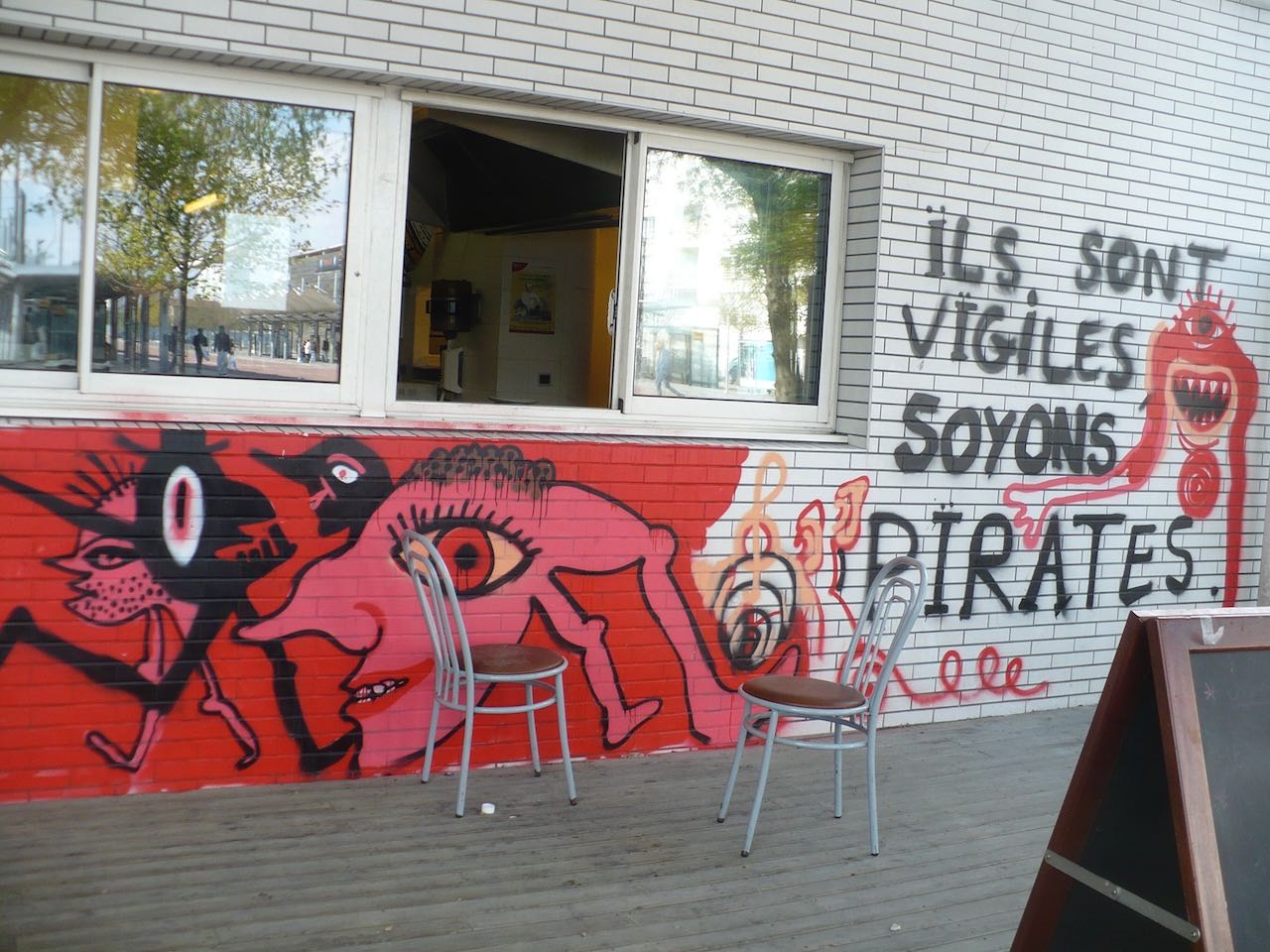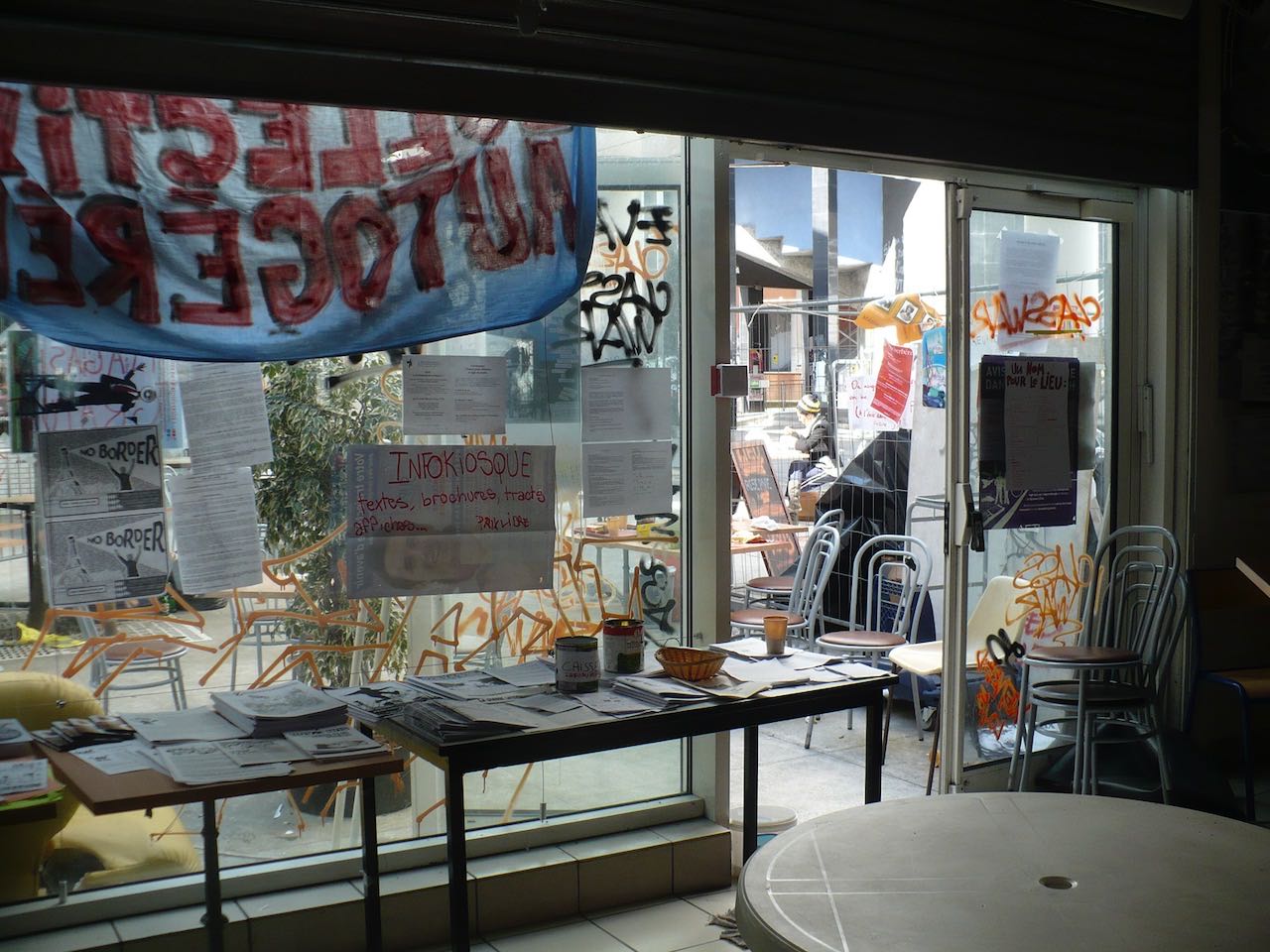While the campus administration was busy creating glossy monuments to the radical past, student militants were demanding “self-managed space” on campus. The administration never gave them any, but eventually they took some for themselves, crafting an autonomous, mixed-gender space of sociability just across from the glossy exhibition space.
“How do you get in?” I asked. The gates of the university were shut and it was a Saturday night.
The light fell from the windows of the occupied space, shining over the dirty surface of the sidewalk and the white bricks of the walls, blurring and dimming as it ran out to the bus depot and the metro station, dwindling into the night and the empty lots and avenues running off into the long banlieue cityscape. The streets were quiet. As I approached the occupation, I discovered a chair set beside an open window. A young woman in a red sweater was cooking at a large industrial stove, and she gestured me to climb through the window. The scene was vaguely nautical: “They are sentries, let’s be pirates,” said the graffiti beside the window.

The space had been a commercial cafe, with counters and an industrial kitchen, windows half-covered with metal shutters, long tables and chairs backed with metal bars. The security post at the entrance ostensibly kept an eye on the occupiers. As the occupation continued, concerns mounted among the local administration. But according to the occupiers themselves, the occupation was outside the security force’s jurisdiction, since the occupied cafe was leased to a private company and hence outside their immediate rights of intervention. In any event, on the night of my visit, I found a space transformed, redecorated, rearranged, and suddenly full of light.

One corner was a communal sleeping spot, with mattresses and a few dividers for privacy. Near the entrance were piles of activist literature, a feminist library, and a clothing swap. Signs and posters told the history of the effort to inhabit the space, including grocery lists, lists of chores, a list of names for the space, and a list of bakeries and supermarkets with spare food. I felt almost at home, even though I saw only a few people I knew. There was Iris from philosophy; we were not yet friends. An activist with the New Anticapitalist Party, whom I’d seen before, filled me in on the news. “The owner stopped by and said he’s going to file a complaint, but hasn’t done it yet. There’s a procedure for squats, we don’t get kicked out right away, you have to see the commissariat…”

They fed us pasta with a bit of cucumber and tomato, beans, and purloined bread. I was asked not to photograph anyone’s faces. In the courtyard two short-haired men were talking about Georges Sorel and French anarchists’ role in the origin of fascism. There was a lot I didn’t catch, a lot that was too quick and too soft, and it was night, the beams of the building towering over, an anomalous dog barking in the night. A law student with an injured eye told me that a former university president, known for corruption, had sold off public property to a company, which had leased it to a second company, which had leased it to the current tenants. Failing to make a profit, the space had been deserted with two months left on the lease.
It was a multiracial and fairly subaltern space. It was also an activist space, one far to the “left” of representative campus governance (Rose 2019). It was a space of mixing, of consumption, and of experiments. By breaking down the usual security barriers around campus, by embracing graffiti messages and highly diverse group composition, the occupiers created a university space that was both in and of the banlieue.
Yet it was conflict with the banlieue that was the undoing of the project. The night after I visited, there was a fistfight. Apparently it took place between the occupying students and some of the teenagers from the neighborhood. No one would explain it in much detail, but I understood that it ended in injuries and hospitals. Someone eventually told me that there had been a dispute over “theories of joint property.” Apparently, the neighborhood kids had attempted to make off with kitchen equipment from the occupied space, and had been opposed by the student occupiers. Afterwards, the organizers, including Iris, sent around a communique which testified to their demoralization.
Sunday night around 8pm, grave incidents took place at the occupied site at Paris 8. The occupants present at the time have therefore decided to close the space for the night. No cops, no security guards, just the reality of the fact that self-management sometimes has its shortcomings.
The occupied space at Paris 8 will only be occupied when people want to bring alive some projects, workshops, alternatives. Otherwise it’s just a big heated room for scratching our balls. Our utopias go a little farther than that, right?
Come on Monday April 12th at 11:30am to clean up, and 6pm for the General Assembly, where we’ll discuss our developing projects.
What happened instead was that the university administration took the opportunity after a few more days to padlock the doors to the space. The occupation ended. “The open space is now closed,” Ishmael wrote to me sardonically. One of the occupation’s many spray-painted slogans had read: “Let’s eat them before they eat us.” But as it turns out, it was the occupation that got eaten first. It was a disappointing outcome.
This disappointment was itself a reaction. The organizers had previously explained, in the communique announcing the occupation, that they were occupying in response to their own disappointment with the mass university. This university was premised, they noted, on a passive, consumerist role for students.
Since Tuesday April 6th, a space abandoned at the entry of the St. Denis campus territory has been recuperated. This reappropriation is a necessity. Today, the campus is doing nothing to allow us to meet, exchange, organize or struggle. The university cannot be a mere passageway or of the consumption of coursework. Opening this place up is taking things into our own hands [prendre les choses en main], ceasing to be passive, transcending the standard academic framework, bringing the city to life within the university. It belongs to no one; anyone can live there and bring it alive.
We are reappropriating this space to make it into a place of solidarities, of sharing, of struggles. We want to organize ourselves outside the logics of representation and the frameworks imposed by the university: schedules, institutional policy, occupation of space. We are experimenting with a place for debates, a place for sharing knowledge and practices.
The aspiration was admirable. Yet in the end, the occupation could not produce a genuine integration between the university and the city. It testified instead to the fundamental ambivalence that organized this relationship. Whatever else may have happened, it is clear that the occupation could not fully integrate socially with the inhabitants of the local neighborhood. Rather, its violent ending indicated the physical tensions that separated one group from the next. Yet the provisional life of the occupation also revealed the desire to make the university into a home. The occupiers sought to develop an alternative form of university governance, “self-management” (autogestion), which was centered on direct democracy and an abolished division of labor.
I would not call this occupation an intervention into the relations of intellectual production at the university. It had relatively little bearing on the production of diplomas or scholarly research. Rather, it was an intervention into the relations of reproduction: the politics of space, of everyday life, and of dwelling in the mass university. It seemed on its surface to have been a failure: a year later, it was all but entirely forgotten. Yet if nothing else, it helped sustain the longstanding campus tradition of occupying university spaces. The university had first been occupied in its very first month of operation, in January 1969, and occupations had continued frequently over subsequent decades. In 2018, some 200 African refugees occupied a campus art building for almost five months, before they were finally removed by the riot police.[10] What was the deeper truth of all these occupations — their utopian arts of dwelling, or their ultimate failure and removal?
To be utopian is to create space, to redefine the way we use space, to protest dominant uses of space. It might mean reopening that which has been enclosed. It might mean reopening tensions that are impossible to resolve. To be utopian is to be honest about how spaces fail.
-
“Université Paris 8 : des migrants évacués du bâtiment qu’ils occupaient,” Le Parisien, 26 June 2018, http://www.leparisien.fr/seine-saint-denis-93/universite-paris-8-intervention-des-forces-de-l-ordre-pour-evacuer-des-migrants-26-06-2018-7793931.php. ↩